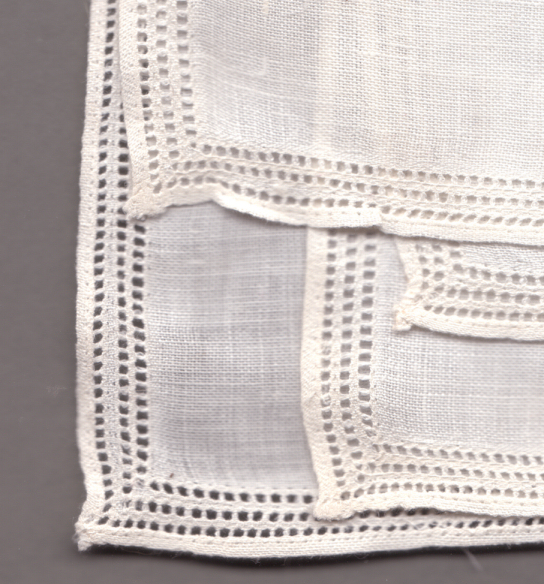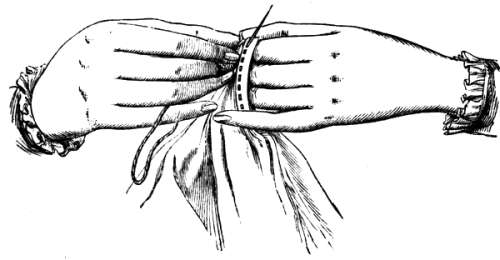|
Hem-stitch
Hemstitch or hem-stitch is a decorative drawn thread work or openwork hand-sewing technique for embellishing the hem of clothing or household linens Linens are fabric household goods intended for daily use, such as bedding, tablecloths, and towels. "Linens" may also refer to church linens, meaning the altar cloths used in church. History The earliest known household linens were made f .... Unlike an ordinary hem, hemstitching can employ embroidery thread in a contrasting color so as to be noticeable. In hemstitching, one or more threads are drawn out of the fabric parallel and next to the turned hem, and stitches bundle the remaining threads in a variety of decorative patterns while securing the hem in place. Multiple rows of drawn thread work may be used.Dillmont (1884), p. 24Reader's Digest (1992), pp. 78–83 Hand hemstitching can be imitated by a hemstitching machine which has a piercer that pierces holes into the fabric and two separate needles that sew the ... [...More Info...] [...Related Items...] OR: [Wikipedia] [Google] [Baidu] |
Drawn Thread Work
Drawn thread work is one of the earliest forms of open work embroidery, and has been worked throughout Europe. Originally it was often used for ecclesiastical items and to ornament shrouds. It is a form of counted-thread embroidery based on removing threads from the warp and/or the weft of a piece of even-weave fabric. The remaining threads are grouped or bundled together into a variety of patterns. The more elaborate styles of drawn thread work use a variety of other stitches and techniques, but the drawn thread parts are their most distinctive element. It is also grouped with whitework embroidery because it was traditionally done in white thread on white fabric and is often combined with other whitework techniques. History Drawn thread embroidery is a very early form of open work embroidery, and is the basis of lace. Drawn thread work from the 12th century was known as Opus Tiratum and Punto Tirato from the Arab Tiraz workshops in Palermo. Forms of drawn thread work were kno ... [...More Info...] [...Related Items...] OR: [Wikipedia] [Google] [Baidu] |
Hemstitch
Hemstitch or hem-stitch is a decorative drawn thread work or openwork hand-sewing technique for embellishing the hem of clothing or household linens. Unlike an ordinary hem, hemstitching can employ embroidery thread Embroidery thread is yarn that is manufactured or hand-spun specifically for embroidery and other forms of needlework. Embroidery thread often differs widely, coming in many different fiber types, colors and weights. Threads for hand embroidery i ... in a contrasting color so as to be noticeable. In hemstitching, one or more threads are drawn out of the fabric parallel and next to the turned hem, and stitches bundle the remaining threads in a variety of decorative patterns while securing the hem in place. Multiple rows of drawn thread work may be used.Dillmont (1884), p. 24Reader's Digest (1992), pp. 78–83 Hand hemstitching can be imitated by a hemstitching machine which has a piercer that pierces holes into the fabric and two separate needles that sew the ho ... [...More Info...] [...Related Items...] OR: [Wikipedia] [Google] [Baidu] |
Openwork
Openwork or open-work is a term in art history, architecture and related fields for any technique that produces decoration by creating holes, piercings, or gaps that go right through a solid material such as metal, wood, stone, pottery, cloth, leather, or ivory. Such techniques have been very widely used in a great number of cultures. The term is rather flexible, and used both for additive techniques that build up the design, as for example most large features in architecture, and those that take a plain material and make cuts or holes in it. Equally techniques such as casting using moulds create the whole design in a single stage, and are common in openwork. Though much openwork relies for its effect on the viewer seeing right through the object, some pieces place a different material behind the openwork as a background. Varieties Techniques or styles that normally use openwork include all the family of lace and cutwork types in textiles, including broderie anglaise and many ... [...More Info...] [...Related Items...] OR: [Wikipedia] [Google] [Baidu] |
Sewing
Sewing is the craft of fastening or attaching objects using stitches made with a sewing needle and thread. Sewing is one of the oldest of the textile arts, arising in the Paleolithic era. Before the invention of spinning yarn or weaving fabric, archaeologists believe Stone Age people across Europe and Asia sewed fur and leather clothing using bone, antler or ivory sewing-needles and "thread" made of various animal body parts including sinew, catgut, and veins. For thousands of years, all sewing was done by hand. The invention of the sewing machine in the 19th century and the rise of computerization in the 20th century led to mass production and export of sewn objects, but hand sewing is still practiced around the world. Fine hand sewing is a characteristic of high-quality tailoring, haute couture fashion, and custom dressmaking, and is pursued by both textile artists and hobbyists as a means of creative expression. The first known use of the word "sewing" was in the ... [...More Info...] [...Related Items...] OR: [Wikipedia] [Google] [Baidu] |
Clothing
Clothing (also known as clothes, apparel, and attire) are items worn on the body. Typically, clothing is made of fabrics or textiles, but over time it has included garments made from animal skin and other thin sheets of materials and natural products found in the environment, put together. The wearing of clothing is mostly restricted to human beings and is a feature of all human societies. The amount and type of clothing worn depends on gender, body type, social factors, and geographic considerations. Garments cover the body, footwear covers the feet, gloves cover the hands, while hats and headgear cover the head. Eyewear and jewelry are not generally considered items of clothing, but play an important role in fashion and clothing as costume. Clothing serves many purposes: it can serve as protection from the elements, rough surfaces, sharp stones, rash-causing plants, insect bites, by providing a barrier between the skin and the environment. Clothing can insulate against ... [...More Info...] [...Related Items...] OR: [Wikipedia] [Google] [Baidu] |
Linens
Linens are fabric household goods intended for daily use, such as bedding, tablecloths, and towels. "Linens" may also refer to church linens, meaning the altar cloths used in church. History The earliest known household linens were made from thin yarn spun from flax fibres to make linen cloth. Ancient Egypt, Babylon, and Phoenicia all cultivated flax crops. The earliest surviving fragments of linen cloth have been found in Egyptian tombs and date to 4000 BCE. Flax fibres have been found in cloth fragments in Europe that date to the Neolithic prehistoric age. Cotton is another popular fibre for making cloth used for household linens. Its use in cloth-making also dates back to prehistoric times, in Indian subcontinent, China, Peru and Egypt. The Indian subcontinent was especially well known for high quality cotton cloth as early as 1500 BCE. Linen was an especially popular cloth during the Middle Ages in Europe, when cotton was an exotic import. It was used for undercloth ... [...More Info...] [...Related Items...] OR: [Wikipedia] [Google] [Baidu] |
Embroidery Thread
Embroidery thread is yarn that is manufactured or hand-spun specifically for embroidery and other forms of needlework. Embroidery thread often differs widely, coming in many different fiber types, colors and weights. Threads for hand embroidery include: *Crewel yarn is a fine 2-ply yarn of wool or, less often, a wool-like acrylic. *Embroidery floss or stranded cotton is a loosely twisted, slightly glossy 6-strand thread, usually of cotton but also manufactured in silk, linen, and rayon. Cotton floss is the standard thread for cross-stitch. Extremely shiny rayon floss is characteristic of Brazilian embroidery. Historically, stranded silk embroidery threads were described as sleaved or sleided in the sixteenth century. *Filoselle is a historical term for embroidery floss made using the leftover waste from reeled silk. *Matte embroidery cotton (or its French name, ) is a matte-finish (not glossy) twisted 5-ply thread. *Medici or ''broder medici'' is a fine, light-weight wool thread ... [...More Info...] [...Related Items...] OR: [Wikipedia] [Google] [Baidu] |
Stitch (textile Arts)
In the textile arts, a stitch is a single turn or loop of thread, or yarn. Stitches are the fundamental elements of sewing, knitting, embroidery, crochet, and needle lace-making, whether by hand or machine.Picken (1957), p. 322 A variety of stitches, each with one or more names, are used for specific purposes. Sewing, embroidery, and lace Examples include: * Backstitch * Overcast stitch * Cross stitch * Buttonhole or blanket stitch * Chain stitch * Knot stitch These stitches and their variations are named according to the position of the needle and direction of sewing (''running stitch'', ''backstitch''), the form or shape of the stitch (''chain stitch'', '' feather stitch'') or the purpose of the stitch ( tailor's tack, ''hem stitch'').''Reader's Digest'' (1976), pp. 122–143 Sewing machine stitches are classified by their structure: *Chain stitch, made with one thread * Lockstitch, made with two threads *Overlock, made with one to five threads * Coverstitch, made ... [...More Info...] [...Related Items...] OR: [Wikipedia] [Google] [Baidu] |
Sewing Machine
A sewing machine is a machine used to sew fabric and materials together with Thread (yarn), thread. Sewing machines were invented during the first Industrial Revolution to decrease the amount of manual sewing work performed in clothing companies. Since the invention of the first sewing machine, generally considered to have been the work of Englishman Thomas Saint in 1790, the sewing machine has greatly improved the efficiency and productivity of the clothing industry. Home sewing machines are designed for one person to sew individual items while using a single Stitch (textile arts), stitch type at a time. In a modern sewing machine, the process of stitching has been automated so that the fabric easily glides in and out of the machine without the inconvenience of needles, Thimble, thimbles and other tools used in hand sewing. Early sewing machines were powered by either constantly turning a handle or with a foot-operated treadle mechanism. Electrically-powered machines were later i ... [...More Info...] [...Related Items...] OR: [Wikipedia] [Google] [Baidu] |





.jpg)

